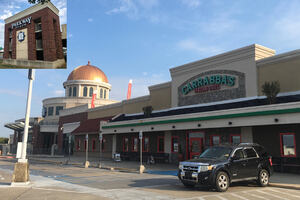
Parkway Place Mall, 2801 Memorial Pkwy
Asia Dezenberg, Fall 2024
This postcard depicts the Parkway Shopping Center, an open-air strip mall opened in Huntsville in 1957 and the predecessor to the modern Parkway Place Mall rebuilt on the same site. The 1959 postcard shows several storefronts, including Walgreen and the now-defunct G. C. Murphy five-and-dime. This is the original mall structure— the site has been rebuilt twice over its sixty-seven year history, becoming an indoor building that has stood the test of time in an economic landscape that has forced many other malls to close their doors. When comparing the old and new buildings, it is clear how Parkway Place’s expansion and adaptation to new trends have ensured its survival as the only enclosed mall remaining in Huntsville.
The original Parkway Shopping Center opened in 1957, starting out as an open-air strip of twenty-five stores with 1,600 parking spaces (Hazel, 2007). The postcard was published two years later in 1959, as evidenced by the Curt Teich “9C-K928” production number in the stamp box: “C” denoting the decade of the 1950s, and “9” meaning the ninth year in that decade (Newberry). By this time, the center was already seeing success, having evidently added ten new stores and six hundred more parking spots. Around this time, the first fully enclosed mall was built to cater to the needs of a rapidly expanding suburban population following World War II (Berger, 2018). It was seen as convenient to gather so many stores into one space, especially within comfortable indoor walking distance, and so in 1974 the company Arlen Real Estate started planning to rebuild Parkway as an enclosed, single-story building (Hazel). The site was half-destroyed by a tornado that year in April, but despite this difficulty, it was rebuilt and reopened as the new Parkway City Mall in 1976 (Hazel). The new building helped business, but one innovation would not be enough to last the stress of the next few decades. It was around the late 1990s and early 2000s when large, big-box companies like Walmart began to take over suburbs and out-compete smaller businesses (Parlette & Cowen, 2010). Huntsville’s success was also booming in the 1990s from tech companies moving to the area, so retail needed to upscale to match (Hazel). The company JMB Realty expanded the building in 1984 and 1994, but Parkway would soon be entirely rebuilt once more after being reacquired by CBL (previously called Arlen) and Colonial Properties (Hazel).
In 2002, the site reopened once more as Parkway Place Mall (Hazel). This new building continued the trend of expansion with an additional second floor; however, what was not a trend was the indoor shopping mall formula itself. Soon after Parkway’s rebuilding, malls started to shift towards an outdoor format to keep up with the consumer preference for airy, luxury spaces—a shift that has been evidenced by the success of outdoor areas like Bridge Street Town Centre, which opened in 2007 (Accardi, 2012). Parkway is a rarity in that aspect because when it was rebuilt, it stayed as an indoor mall, instead of becoming an outdoor shopping center. It has kept its business in part because architecturally, Parkway still keeps up with this consumer preference. The second story is a ringed walkway overlooking the first floor, and this space and the lack of visible pillars makes the whole mall feel open as a result (Hazel). The food court follows this trend, situated under the iconic golden domed atrium that is one of the building’s most defining features from the outside. In the face of an expanding online marketplace that has taken business away from physical stores (Berger), Parkway has also kept its customers with stores that were new to market at its opening, as well as a new layout geared more towards convenience. Stores for similar demographics used to be situated on opposite ends of the mall, so that one would have to walk through the mall and hopefully make purchases before finding what they need, while the new layout situates similar stores next to each other for easy access. The architecture backs this new layout as well, with different railing styles simulating the feeling of different neighborhoods throughout the mall (Hazel). Parkway Place Mall still has an active customer base today, fitting in with open-air centers like Bridge Street instead of one or the other taking over entirely. Its ability to stay in business through the closing of other malls nationwide is a testament to how it has been able to expand and adapt to new trends over time.
